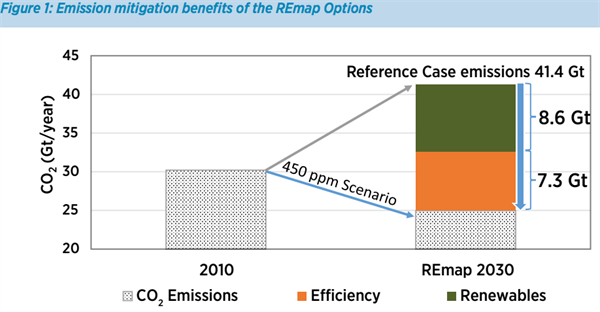Mat Hope
09.06.2014 | 2:40pmThe world could save billions of dollars and avoid dangerous global warming if policymakers double the amount of energy people get from renewable sources, a new report claims.
Sounds great. But the calculation uses a slightly circular logic which relies on the assumption that the alternative – polluting – becomes more costly.
Curbing emissions
The International Renewable Energy Agency (IRENA) calls for governments to increase renewable energy’s global share from 18 per cent of demand in 2010 to 36 per cent in 2030. Doing so could prevent temperatures rising by more than two degrees above pre-industrial levels, it claims.
It bases that statement on figures from the International Energy Agency (IEA). The IEA says global emissions must not exceed 25 gigatonnes in 2030 to prevent warming of more than two degrees. IRENA claims global emissions could be limited to 25.5 gigatonnes in 2030 if policymakers follow its proposals. That’s 15.9 gigatonnes lower than they otherwise may be, as this graph shows:
IRENA concludes “renewable energy and energy efficiency are the world’s best chances to avoid catastrophic climate change”. But it acknowledges those can’t be the only policy focuses.
If global emissions are around 25 gigatonnes in 2030, the IEA says policymakers will have to accelerate their efforts to prevent dangerous warming in the following two decades. That means ensuring policymakers divert resources toward curbing industrial and transport sector emissions, too.
$740 billion
While few people doubt renewable energy’s potential to curb emissions, critics remain concerned about how much a mass rollout could cost. But IRENA says its proposal could save the global economy $740 billion a year by 2030.
The savings would come due to the wider social benefits of switching to renewable energy, it says. But the figure is based on some pretty big assumptions.
Here’s IRENA’s basic calculation:
- Rolling out renewable energy could cost $133 billion per year by 2030.
- But that’s offset by health sector savings of up to $230 billion per year,
- Plus governments and industry avoiding payments of $640 per year for emitting carbon dioxide.
As you can see, the bulk of the saving would come from companies not having to pay to pollute. To get the figure, an IRENA spokesperson tells Carbon Brief it assumed a global carbon price of between $20 and $80 per tonne of carbon dioxide was in place by 2030.
The current state of the world’s carbon markets suggests the top end of that range may be a bit optimistic, however.
Currently, the biggest carbon market in the world, the European emissions trading scheme, has a carbon price of around five Euros ($7). The two regional carbon markets currently operating in the US have been operating with carbon prices of between $2 and $15. Moreover, major energy companies assume the carbon price won’t exceed $60 per tonne in 2030 in their modelling – $20 less than the top end of IRENA’s range.
So the carbon price would have to increase dramatically and roll out globally – which is no small feat – for IRENA’s projection to be accurate.
The rest of the savings come from people being healthier as a result of renewable energy displacing fossil fuels.
IRENA claims millions of people die each year from illnesses related to poor air quality caused by transportation, pollution from fossil fuel power plants, and burning fuels such as wood and coal for heat. Based on a survey of existing research, IRENA estimates the global health impact associated with burning fossil fuels was $325 to $825 billion in 2010.
As energy demand is expected to grow with highly polluting fossil fuels such as coal, oil and gas providing much of the power, the health toll could also increase. IRENA suggests the world could save $90 to $230 billion per year in 2030 if this demand was met by renewable energy sources instead.
While a number of otherreports have come up with similar figures, the data’s complexity can make it hard to quantify the cost of continuing to burn fossil fuels.
For instance, it’s sometimes hard to know when to attribute a death to the effects of burning fossil fuels as people die from a combination of factors. Data can also be hard to come by for certain sectors. In this case, IRENA tells Carbon Brief it had to assume the health impacts of burning fossil fuels were the same in the industrial sector as the power sector.
So while ramping up renewables could save money in some areas, and there are undoubtedly health benefits from replacing fossil fuels, IRENA’s headline figure still relies on a rather optimistic vision of future carbon prices.


